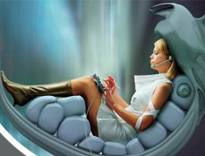|
By James Ricketts | September 2007
What is a Device Driver?
A device driver is a software program that is used to establish
communication between various hardware devices installed on your computer and
the applications that need to use these devices. For instance, a printer driver
enables your Microsoft Word or Excel application to communicate with the printer
and send prints jobs. Common drivers, such as drivers for mouse and keyboards
are shipped along with your operating system. Each device has its own driver. In
Window environments, drivers have the .DRV extension and in DOS environment the
extension is .SYS.
Causes of Driver Errors
Most driver errors, such as
printer errors, display errors, and audio/video errors that are related to
hardware devices occur due to problems with their drivers. Some of the most
common causes of driver errors are:
-
One or more drivers may be utilizing the same system resources,
such as IRQ, memory, and I/O range. This causes
driver conflicts that may result in an error.
-
The driver causing the error is buggy, due to which it is unable
to function as required and is generating errors.
-
The driver and your operating system are incompatible. For
instance, if a recently installed printer driver is not compatible with
Windows XP, a driver error will be generated.
-
Just like all other programs running on your computer, drivers
need to add entries in the registry to make it function. If the registry is
damaged or corrupt or if the driver entries in the registry are incorrect,
then errors will be generated.
-
If the driver is deleted or is damaged due to malicious
infections or incorrect installation, it will result in driver errors.
How to Fix Driver Errors
Usually when a driver error occurs, an error message is displayed.
This error message although useful, does not completely indicate the source of
the problem. To identify the source and fix the error, you will have to perform
a little bit of troubleshooting yourself. But, don’t worry, your XP computer
provides you with options that help you in diagnosing and fixing most device
errors.
Using Device Manager
To open the Device Manager window, right-click on the My Computer
icon, and select the Properties command. Next, on the Hardware tab, select the
Device Manager button. This will open the Device Manager window.
In the Device Manager window, you can view all hardware devices
that are currently installed and configured on your Windows computer. The faulty
hardware is marked with a yellow triangle consisting of a black exclamation mark
within it. After you have identified the faulty hardware in the Device Manager
window, right-click on it and select Properties.
Depending on the device, there will be a number of tabs in the
properties dialog box.
On the Resources tab, you can check the resource allocation and modify resource
settings to stop driver conflict errors.
If the driver of your device is outdated, then on the Driver tab,
select the Update Driver button to search for and install updates for this
driver. If the driver has gone corrupt and you want to uninstall and reinstall
the driver, then select the Uninstall button. If the recent update of your
driver is faulty, then to restore the original driver select the Roll Back
Driver button.
Using Recovery Console
If you are unable to fix the error using Device Manager, then use
the Recovery Console to rename the driver and replace the original driver from
its installation file. This method is useful in fixing drivers that come with
your XP operating system. To
fix
driver errors using Recovery Console, perform the following steps:
-
Insert thebWindows XP installation CD in your CD-drive and
restart your PC.
-
When the “Welcome to Setup” screen is displayed, select R.
-
Login using a user name that has administrative rights to your
system.
-
Type cd windows\system32\drivers, and press Enter to change to
the Drivers directory.
-
Next, to rename the damaged driver file, type ren
Driver_Name.sys Driver_Name.old and press Enter.
-
Now, type “copy CD-Drive:\i386 Driver_Name.sys’ and press Enter
to copy the original file of the driver to the Drivers folder.
-
Exit Recovery Console, remove the XP CD, and restart your PC. To
prevent driver errors from occurring on your system, you need to perform
regular preventive maintenance of your PC. Always keep your PC updated with
the latest security updates and patches. Run regular antivirus and antispyware
scans, and keep the two utilities updated with the latest virus definitions to
ensure that your PC is free from malicious programs. Finally, regularly use a
registry cleaner tool to scan the Windows registry and repair registry errors.
To prevent driver errors from occurring on your system, you need
to perform regular preventive maintenance of your PC. Always keep your PC
updated with the latest security
updates and patches. Run regular antivirus and antispyware scans, and keep
the two utilities updated with the latest virus definitions to ensure that your
PC is free from malicious programs. Finally, regularly use a registry cleaner
tool to scan the Windows registry and repair registry errors.
|

![]()






